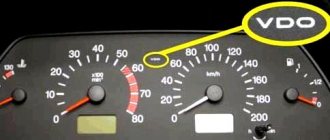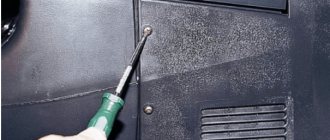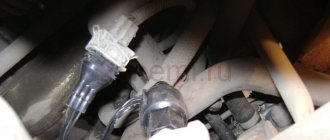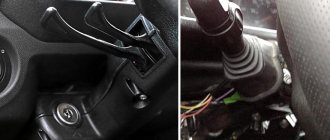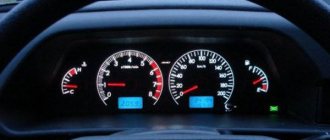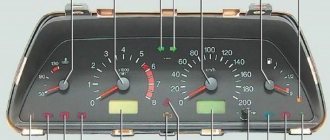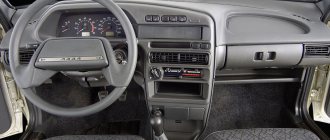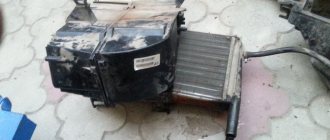Replacing the light bulbs in the dashboard of a VAZ 2110 yourself
Installation of the dashboard on a VAZ 2110
The dashboard of the VAZ 2110 car is designed to reflect information about the current condition of the car. Made from ordinary plastic.
The presence of a huge number of light bulbs leads to the need to replace them from time to time. Many drivers want to replace the unsightly factory panel of the VAZ 2110 with a more modern one.
The article suggests finding out how to replace the dashboard bulbs of a VAZ 2110 and how to make it more aesthetically pleasing.
Features of the dashboard of the VAZ 2110 car
Dashboard VAZ 2110
The composition on the dashboard of a VAZ 2110 car dashboard includes:
- 1 – indicates the temperature of the cooling water. If the arrow of this indicator moves into the reddish zone of the scale, this indicates overheating of the motor.
You need to pay attention to the operation of the electric fan and thermostat of the cooling system.
Tip: Do not operate the motor in overheating mode. Water temperature is more than 110 °C.
- 2 – tachometer. Shows the approximate frequency at which the engine crankshaft rotates.
To get the real value of the unit’s rotation speed, you need to multiply the device’s arrow reading by 100. The arrow reading in the reddish zone means that the engine is operating at an increased frequency, which is unsafe for the vehicle to continue moving.
- 3 – speedometer. The position of the arrow indicates the approximate speed of the car in km/h.
- 4 – indicates the fuel level.
- 5 – reset button on the daily mileage counter.
- 6 – screen for the trip odometer and odometer.
- 7 – screen for indicating the time.
- Positions 1 – used to illuminate device hands and scales.
- Positions 2 – the smallest in size are used in yellowish indicators and burgundy signal indicators. Such light bulbs are installed without rubber caps. Light filters of suitable colors are already integrated into the device.
- Position 3 – has a medium size, used to indicate a low gasoline level, just when the needle is at zero. It burns out very rarely.
The photo shows the installation of light bulbs on the panel:
Installing light bulbs on the panel
The entire arrangement of devices is fixed with 2 screws in the corresponding slot on the dashboard. Its connections are made using printed circuit board mounting using foil getinax. The board is perfectly attached to the back of the case.
The speedometer is equipped with 2 counters showing the distance traveled: one is total, the other is “daily”. Using the corresponding button, the readings of the latter are simply reset.
Tip: Readings can only be reset when the car is stationary.
The latest VAZ 2110 models are equipped with an electric dashboard. It contains all components and control indicators, icons and lamps.
Description and location of indicators and instruments on the panel
Let's start with a description and designation of the instrument panel icons and symbols in 21102:
- Engine coolant temperature controller; this sensor determines the temperature of the engine as a whole. Thanks to the device, it is possible to promptly detect overheating of the power unit.
- Tachometer. This controller is designed to display crankshaft speed readings.
- The left turn signal indicator always flashes when the turn is turned on.
- Left right turn signal. Icons numbered 3 and 4 blink synchronously when the light alarm is turned on.
- Speedometer. Thanks to the speedometer, the driver can know how fast his car is moving.
- A controller for the volume of remaining fuel in the tank, which helps the driver navigate when to refuel. If there are about 5-7 liters of fuel left in the tank, a yellow indicator in the form of a gas pump will light up next to the sensor. Do not operate a car with a yellow light on regularly, as this can lead to failure of the fuel pump.
- The gas station indicator, which we described above.
- Light symbol for turning on the side lights.
- The brake system performance symbol appears on the instrument panel when the engine is running if there is not enough brake fluid in the expansion tank. The problem may be due to a leak.
- High beam activation icon.
- Clock setting regulator with switch. Can be used to switch between daily and total mileage data.
- At the bottom of the instrument cluster there is a small screen that displays data on the vehicle's kilometers traveled.
- A light bulb that lights up when the light alarm is activated.
- Check Engine symbol. Its appearance indicates that the control unit has detected a problem with the motor. It is advisable to turn off the power unit and identify the breakdown, which is often caused by the inoperability of auxiliary sensors.
- Clock screen. When the regulator is switched, it may display data on the outside air temperature if such a sensor is installed.
- This instrument lamp indicates a detected malfunction in the battery charging system. The cause may be a loose, worn or broken generator set drive belt. It may also indicate a malfunction of the unit itself, damage to the power circuit and other problems in its operation.
- Handbrake activation icon.
- The symbol in the form of an oil can indicates an insufficient level of engine fluid pressure in the internal combustion engine. When it appears, you need to turn off the car engine and find the cause, which is usually an oil leak from the system.
- The air damper icon is placed only on carburetor engines (the author of the video is the In the Garage channel).
Features of the old and new dashboard
Over the decades of production of the VAZ 2110, the dashboard has undergone certain changes. Therefore, devices can be divided into two groups - devices of the old and new models. It should be noted that these dashboards are not interchangeable, since they have different electrical connection diagrams, as well as designs of the central console in the cars. Moreover, both types of devices are characterized by different shapes, but as for the location of sensors and indicators, in fact it is almost the same.
Replacing the backlight on the dashboard
Dashboard sign for VAZ 2110
To do this, you need to use the following algorithm:
- The panel should be removed.
- The illumination designation is determined by special LED bulbs. To replace the backlight, these bulbs must be removed.
Note: this must be done very carefully, because they are quite small. In addition, there is a possibility of damaging the panel itself.
- But before that you need to disassemble it. This is not a difficult task, as to disassemble it you just need to press the latches, thanks to which you can remove the bulbs.
- Everyone has seen that on top of the dashboard there is a “sticker” and symbols (speed, amount of gasoline). It is held on by glue, so to remove it you will have to dig around a little.
Remaining glue must be removed.
- You can start replacing the backlight.
Note: it is advisable to choose colors that are not very bright and strain the eyes. White or blue colors are ideal.
- To remove the light filter located on the back of the “sticker”, you need to take a utility knife. The light filter is located under the protective layer. First you need to remove it. Do not press too hard with the knife, as necessary parts may be damaged.
Description of dashboard tuning
Note: it is easier to remove it if you rub it with a knife in one direction, then in the other.
- To insert LED bulbs, you must remove the board located in the plastic case. There will be special holes for them.
Panel instrument pinout
Note: but that's not all, you will need to solder the wiring of the light bulbs to the board for them to work.
- Now we need to put everything back together and install it correctly.
Instrument control panel illumination
To illuminate the stove, you first need to carefully remove the plastic handles of the levers that control the dampers and remove the glass. Below it is the stove itself. To do this, take any sharp object (knife or scissors) and carefully pry the glass. Prepare foil according to its size. It will be an additional source of illumination.
Fixed on the inside of the glass, it will give a very attractive appearance to the stove, and the console illumination will not be concentrated only in the place where the LED is installed next to the handle.
The next step is to remove the lamp socket from the backlight of the stove control unit. The lamp must be replaced with a purchased LED. In order for the light to spread around the entire perimeter of the stove, an LED strip is used, which is glued to the bottom. Two wires are usually soldered to the contacts, which are connected to the cartridge.
All connections are carefully insulated. Assembly is carried out in reverse order. If one of the parts does not work, check all contacts and connections again. The lighting of the stove control panel will become much better and more modern; the light from it will spread throughout the entire perimeter both day and night.
READ Replacing Nissan front brake pads x
Illumination of the heater (stove) control console.
Remove the plastic handles for the heater damper control levers. Remove the glass of the stove control unit by picking it up with a knife. We make a reflector out of foil and fix it under the glass of the VAZ 2109 heater control unit. If it is not made, the console backlight will be concentrated only in the place where the backlight LED is installed next to the heater fan speed control knob, and will decrease towards the opposite area, which does not look very good attractive.
Then we unscrew the lower part of the center console (the beard), remove the socket with the backlight lamp for the heater control unit and change the lamp to an LED. We put everything back together in reverse order.
It should be noted that simply replacing the backlight lamp with an LED one, despite all the tricks, will not achieve completely uniform illumination of the heater control panel. Although this is still better than the standard backlight.
To finalize the illumination of this unit, it is best to stick a 10 cm long LED strip to the bottom, solder 2 wires (plus and minus) to its contacts, and connect the wires to the backlight lamp socket of this unit. Just act carefully, do not leave uninsulated sections of wires to avoid a short circuit!
LED strip for illuminating the heater control panel
Now the backlight of the heater control panel glows brightly and evenly over the entire area. Moreover, this illumination is noticeable both day and night.
Illumination using LED strip
This is what the backlight looks like during the day
However, if in the daytime everything is great with the backlight, then when it got dark, I realized that the brightness of such a backlight was excessive for me, and it would be nice to make it a little less bright. You can, of course, adjust the brightness of the entire instrument panel illumination using the corresponding regulator to the left of the steering wheel, but the brightness of the remaining instrument panel illumination lamps suited me, so I did it differently. We take a black marker and paint over the coating above the LEDs (my LED strip is insulated) to the desired level of light transmission - and the problem of excess brightness is solved. The photo above shows a version of the backlight already modified in this way. You can also cover the LED strip with a piece of tint film, the effect will be the same.
Separately illuminated arrows
LEDS IN THE INSTRUMENT PANEL FOR VAZ 2110 2111 2112
Video guide for replacement
DIY
instrument panel for
VAZ 2110 An example of replacing
...
How to remove the instrument panel on a VAZ 2110, 2111, 2112 and replacing light bulbs
Video review - Backlight styling
interior of a
VAZ 2110 car, replacing
all incandescent light bulbs with diodes on
the panel
...
LED instrument panel VAZ 2110
If you want the arrows to glow a different color, you can do the following:
Note: in this case, the arrows will light up in a different color only when ignited.
How to change the backlight using color film
Old dashboard of VAZ 2110
In order to change the color of the dashboard lighting, it is not necessary to change the LED bulbs.
To do this you can simply:
- Take 12 LEDs and an LED strip.
- Remove the light bulbs from the base and insert one LED at a time in their place.
- You need to take the required amount of LED strip.
Instrument panel diagram
Note: its length is measured according to the size of the panel.
- The base and LEDs must be returned to their original location.
- The tape should be glued to the plastic of the panel (the appropriate temperature must be maintained).
- Tighten the block well.
How to assemble and disassemble the panel
To reset the speedometer or fix the problem that the turn signal light on the dashboard is not blinking, it must be removed.
To this end, you should perform the following actions:
- You can remove the cover, but the board will still be locked.
- You need to take a Phillips screwdriver and use it to remove a few more bolts.
- Now you need to unlatch the latches on the panel. You should start from the bottom. If they were disconnected from the bottom side, then you can push them up. This way the fee will be removed quickly.
- The arrows will have to be removed anyway.
Note: some arrows are easy to remove, but the arrows for the gasoline quantity indicator are much more difficult to remove. To remove the arrows, you need to gently pull them.
- The panel is disassembled, now we need to try to solve the problem.
Note: There are very small LEDs on the board that can also burn out. Because of them, the turn signal light may not blink, so they need to be replaced.
This requires working with a soldering iron.
But if the panel was disassembled in order to reset the speedometer readings, then:
Now it is advisable to somehow put the panel back together.
This is made even easier:
- Place the board in a plastic case.
Note: It is advisable to have a clean cloth underneath to prevent the surface from being scratched.
- Now you need to screw in the bolts on the panel itself. They do not need to be completely screwed in yet, as the arrows must be put in place first.
- Before putting the hands back in place, they need to be wiped thoroughly, as fingerprints, dirt, etc. will be visible when exposed to light.
Note: the arrows should be set approximately 3-4 mm below zero. It is also important that there is a small gap between the needles and the speedometer, otherwise they will stick.
It is much easier to install, as well as remove, long arrows. To install short arrows, you need to act very carefully, as they are more delicate compared to long ones.
- Before installing the glass, it also needs to be wiped. Now snap onto the latches.
- Secure the board with bolts.
- Lastly, screw in the screws on the cover, and then put all the light bulbs in place.
Working with a panel in a car is probably the simplest thing it can be. Therefore, there is no point in going to a car service center, where the price even for such trivial work will be high.
It’s better to look through a bunch of photos and videos before you decide to do repairs and tuning of the car’s interior with your own hands, so as not to harm the car. Any instructions will help you get the job done quickly and efficiently.
The instrument panel of the VAZ 2110 is boring and unsightly, but everything changes when they arrive - white LEDs.
About 8 years ago I myself assembled LED lighting for my six from what I had. Now the choice of LEDs is simply huge and without any problems I simply replaced the dashboard backlight bulbs with LED ones. The transformations pleased me.
Panel painting
VAZ 2114: designation of the instrument panel, indicator lamps, buttons and bi BSK-10
You can update the appearance of the car interior by painting the plastic, the look will be tuning, and the costs will be minimal:
- And since first you will need to “get your teeth into”, we will start this work with the simplest part - the air duct
- Before painting, of course, it will be necessary to dismantle these parts
- To remove the deflectors you will need a flathead screwdriver because they are secured with special plastic latches
- However, you should act very carefully, the latches break easily, then you will have to buy new ones in the store
- Immediately after removing the necessary plastic elements, do not rush to paint them immediately
- In this case, the paint will not last very long, and you will have to repaint them again very soon
- Therefore, first you need to thoroughly wipe the surface of the plastic from dust and dirt, then degrease it using white spirit or another solvent that does not corrode the plastic.
Removed air ducts and door plastic panels
- For painting we use paint exclusively in cans; it must be painted in several layers
- And after painting, we dry the parts, and only after that we can start varnishing
- It is advisable to apply the varnish in several layers from a can or sprayer.
- In about a day you can install the painted and varnished elements in their places
- In addition, it is worth knowing that the paint for such work should be chosen that is heat-resistant, since otherwise exposure to direct sunlight can significantly damage it; harmful fumes negatively affect the health of passengers and the driver of the car.
- After that it's time to paint the torpedo
- Painting the dashboard inside the cabin will be very problematic, so we recommend dismantling it first
- We remove the dashboard, clean it of dust and dirt, then carefully degrease it
- After this we apply black paint, also several layers, but there is no need to varnish the panel
- And after drying, you can install your dashboard back into the interior.
- Well, if you are too lazy to dismantle the panel, and still decide to paint it directly inside the car, then you should try very hard
- First, you should cover the entire interior with film, then move the seats back and then start painting
- And don’t forget to use personal protective equipment, be sure to wear a respirator and rubber gloves on your hands
- After painting, it is necessary to drive the car into a dark garage to protect it from direct sunlight.
- Open all doors and windows
- The final drying of the paint will occur in about a week, but if you have a strong desire to try out a car with a self-updated dashboard, then you can do this no earlier than in a day

